TCP网络编程
Posted lemonzhang
tags:
篇首语:本文由小常识网(cha138.com)小编为大家整理,主要介绍了TCP网络编程相关的知识,希望对你有一定的参考价值。
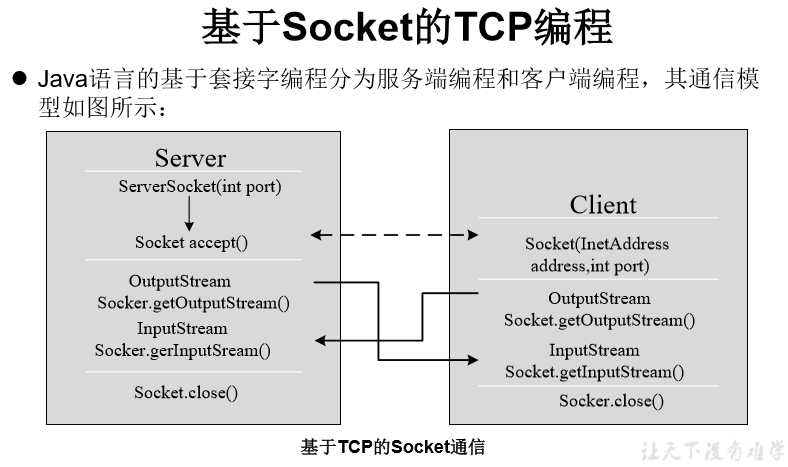
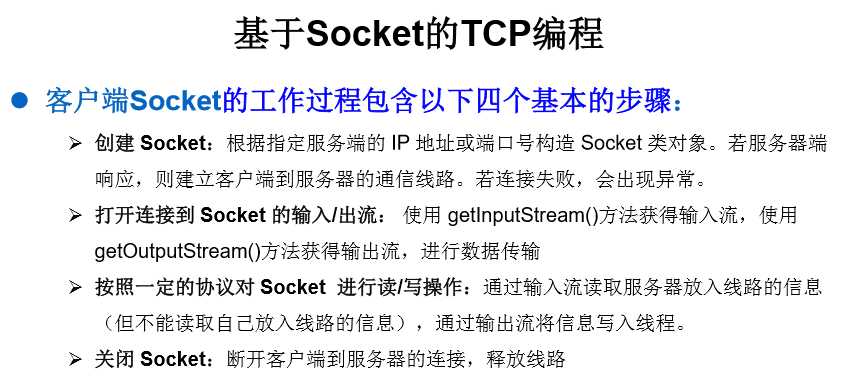
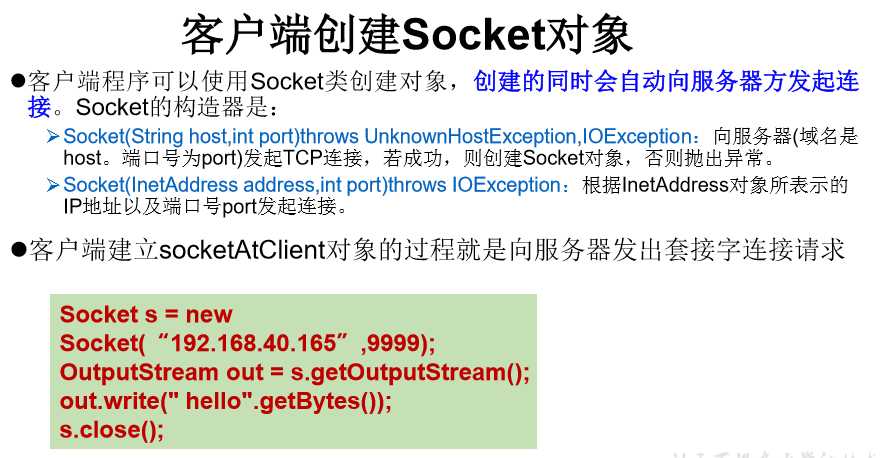
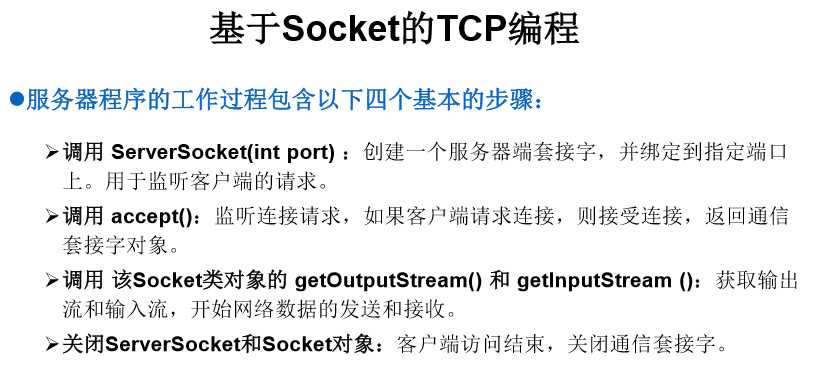
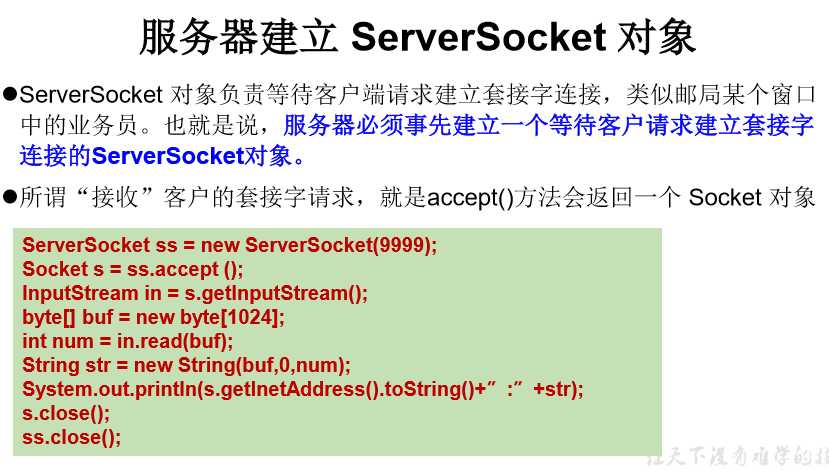
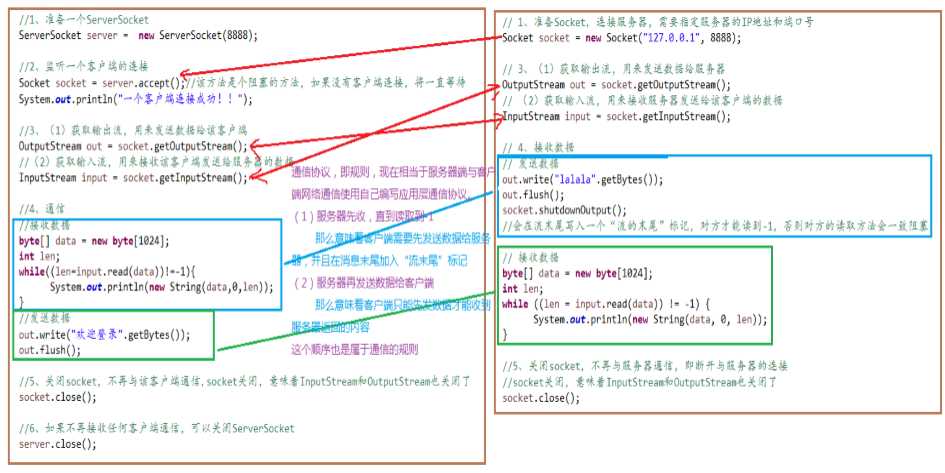
代码示例1:客户端发送信息给服务端,服务端将数据显示在控制台上 //客户端 @Test public void client() { Socket socket = null; OutputStream os = null; try { //1.创建Socket对象,指明服务器端的ip和端口号 InetAddress inet = InetAddress.getByName("192.168.14.100"); socket = new Socket(inet,8899); //2.获取一个输出流,用于输出数据 os = socket.getOutputStream(); //3.写出数据的操作 os.write("你好,我是客户端mm".getBytes()); } catch (IOException e) { e.printStackTrace(); } finally { //4.资源的关闭 if(os != null){ try { os.close(); } catch (IOException e) { e.printStackTrace(); } } if(socket != null){ try { socket.close(); } catch (IOException e) { e.printStackTrace(); } } } } //服务端 @Test public void server() { ServerSocket ss = null; Socket socket = null; InputStream is = null; ByteArrayOutputStream baos = null; try { //1.创建服务器端的ServerSocket,指明自己的端口号 ss = new ServerSocket(8899); //2.调用accept()表示接收来自于客户端的socket socket = ss.accept(); //3.获取输入流 is = socket.getInputStream(); //不建议这样写,可能会乱码 // byte[] buffer = new byte[1024]; // int len; // while((len = is.read(buffer)) != -1){ // String str = new String(buffer,0,len); // System.out.print(str); // } //4.读取输入流中的数据 baos = new ByteArrayOutputStream(); byte[] buffer = new byte[5]; int len; while((len = is.read(buffer)) != -1){ baos.write(buffer,0,len); } System.out.println(baos.toString()); System.out.println("收到了来自于:" + socket.getInetAddress().getHostAddress() + "的数据"); } catch (IOException e) { e.printStackTrace(); } finally { if(baos != null){ //5.关闭资源 try { baos.close(); } catch (IOException e) { e.printStackTrace(); } } if(is != null){ try { is.close(); } catch (IOException e) { e.printStackTrace(); } } if(socket != null){ try { socket.close(); } catch (IOException e) { e.printStackTrace(); } } if(ss != null){ try { ss.close(); } catch (IOException e) { e.printStackTrace(); } } } } 代码示例2:客户端发送文件给服务端,服务端将文件保存在本地。 /* 这里涉及到的异常,应该使用try-catch-finally处理 */ @Test public void client() throws IOException { //1. Socket socket = new Socket(InetAddress.getByName("127.0.0.1"),9090); //2. OutputStream os = socket.getOutputStream(); //3. FileInputStream fis = new FileInputStream(new File("beauty.jpg")); //4. byte[] buffer = new byte[1024]; int len; while((len = fis.read(buffer)) != -1){ os.write(buffer,0,len); } //5. fis.close(); os.close(); socket.close(); } /* 这里涉及到的异常,应该使用try-catch-finally处理 */ @Test public void server() throws IOException { //1. ServerSocket ss = new ServerSocket(9090); //2. Socket socket = ss.accept(); //3. InputStream is = socket.getInputStream(); //4. FileOutputStream fos = new FileOutputStream(new File("beauty1.jpg")); //5. byte[] buffer = new byte[1024]; int len; while((len = is.read(buffer)) != -1){ fos.write(buffer,0,len); } //6. fos.close(); is.close(); socket.close(); ss.close(); } 代码示例3:从客户端发送文件给服务端,服务端保存到本地。并返回“发送成功”给客户端。并关闭相应的连接。 /* 这里涉及到的异常,应该使用try-catch-finally处理 */ @Test public void client() throws IOException { //1. Socket socket = new Socket(InetAddress.getByName("127.0.0.1"),9090); //2. OutputStream os = socket.getOutputStream(); //3. FileInputStream fis = new FileInputStream(new File("beauty.jpg")); //4. byte[] buffer = new byte[1024]; int len; while((len = fis.read(buffer)) != -1){ os.write(buffer,0,len); } //关闭数据的输出 socket.shutdownOutput(); //5.接收来自于服务器端的数据,并显示到控制台上 InputStream is = socket.getInputStream(); ByteArrayOutputStream baos = new ByteArrayOutputStream(); byte[] bufferr = new byte[20]; int len1; while((len1 = is.read(buffer)) != -1){ baos.write(buffer,0,len1); } System.out.println(baos.toString()); //6. fis.close(); os.close(); socket.close(); baos.close(); } /* 这里涉及到的异常,应该使用try-catch-finally处理 */ @Test public void server() throws IOException { //1. ServerSocket ss = new ServerSocket(9090); //2. Socket socket = ss.accept(); //3. InputStream is = socket.getInputStream(); //4. FileOutputStream fos = new FileOutputStream(new File("beauty2.jpg")); //5. byte[] buffer = new byte[1024]; int len; while((len = is.read(buffer)) != -1){ fos.write(buffer,0,len); } System.out.println("图片传输完成"); //6.服务器端给予客户端反馈 OutputStream os = socket.getOutputStream(); os.write("你好,美女,照片我已收到,非常漂亮!".getBytes()); //7. fos.close(); is.close(); socket.close(); ss.close(); os.close(); }
以上是关于TCP网络编程的主要内容,如果未能解决你的问题,请参考以下文章
VSCode自定义代码片段14——Vue的axios网络请求封装
VSCode自定义代码片段14——Vue的axios网络请求封装